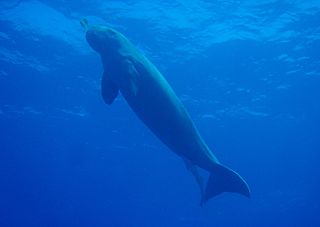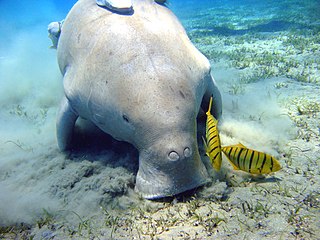 W
WThe Sirenia, commonly referred to as sea-cows or sirenians, are an order of fully aquatic, herbivorous mammals that inhabit swamps, rivers, estuaries, marine wetlands, and coastal marine waters. The Sirenia currently comprise two distinct families: Dugongidae and Trichechidae with a total of four species. The Protosirenidae and Prorastomidae families are extinct. Sirenians are classified in the clade Paenungulata, alongside the elephants and the hyraxes, and evolved in the Eocene 50 million years ago (mya). The Dugongidae diverged from the Trichechidae in the late Eocene or early Oligocene.
 W
WThe Amazonian manatee is a species of manatee that lives in the Amazon Basin in Brazil, Peru, Bolivia, Colombia, Ecuador and Venezuela. It has thin, wrinkled brownish or gray colored skin, with fine hairs scattered over its body and a white chest patch. It is the smallest of the three extant species of manatee.
 W
WThe dugong is a medium-sized marine mammal. It is one of four living species of the order Sirenia, which also includes three species of manatees. It is the only living representative of the once-diverse family Dugongidae; its closest modern relative, Steller's sea cow, was hunted to extinction in the 18th century.
 W
WDugongidae is a family in the order of Sirenia. The family has one surviving species, the dugong, one recently extinct species, Steller's sea cow, and a number of extinct genera known from fossil records.
 W
WSirenia is the order of placental mammals which comprises modern "sea cows" and their extinct relatives. They are the only extant herbivorous marine mammals and the only group of herbivorous mammals to have become completely aquatic. Sirenians are thought to have a 50-million-year-old fossil record. They attained modest diversity during the Oligocene and Miocene, but have since declined as a result of climatic cooling, oceanographic changes, and human interference. Two genera and four species are extant: Trichechus, which includes the three species of manatee that live along the Atlantic coasts and in rivers and coastlines of the Americas and western Africa, and Dugong, which is found in the Indian and Pacific oceans.
 W
WHydrodamalinae is a recently extinct subfamily of the sirenian family Dugongidae. The Steller's sea cow was hunted to extinction by 1768, while the genus Dusisiren is known from fossils dating from the middle Miocene to early Pliocene.
 W
WManatees are large, fully aquatic, mostly herbivorous marine mammals sometimes known as sea cows. There are three accepted living species of Trichechidae, representing three of the four living species in the order Sirenia: the Amazonian manatee, the West Indian manatee, and the West African manatee. They measure up to 4.0 metres (13.1 ft) long, weigh as much as 590 kilograms (1,300 lb), and have paddle-like flippers. The etymology of the name is unclear, with connections having been made to Latin manus (‘hand’), and to a word – sometimes cited as manati – used by the Taíno, a pre-Columbian people of the Caribbean, meaning "breast". Manatees' other name, sea cows, comes from the fact that they are slow plant-eaters, peaceful and similar to cows on land. They often graze on water plants in tropical seas.
 W
WManatees are large marine mammals that inhabit slow rivers, canals, saltwater bays, estuaries, and coastal areas. They are a migratory species, inhabiting the Florida waters during the winter and moving as far north as Virginia and into the Chesapeake Bay, sometimes seen as far north as Baltimore, Maryland and as far west as Texas in the warmer summer months. Manatees are calm herbivores that spend most of their time eating, sleeping, and traveling. They have a lifespan of about 60 years with no known natural enemies. Some of their deaths are the result of human activity. In the past, manatees were exploited for their meat, fat, and hides.
 W
WThe African manatee, also known as the West African manatee, is a species of manatee that is mostly herbivorous. African manatees inhabit much of the western region of Africa – from Senegal to Angola. Although not a great deal is known about this species, it is hypothesized that the African manatee is very similar to the West Indian manatee.
 W
WSnooty was a male Florida manatee that resided at the South Florida Museum's Parker Manatee Aquarium in Bradenton, Florida. He was one of the first recorded captive manatee births, and at age 69, he was the oldest manatee in captivity, and possibly the oldest manatee in the world. Due to his hand rearing from birth, Snooty was never released to the wild and was the only manatee at the museum's aquarium that had regular human interaction.
 W
WSteller's sea cow is an extinct sirenian described by Georg Wilhelm Steller in 1741. At that time, it was found only around the Commander Islands in the Bering Sea between Alaska and Russia; its range was more extensive during the Pleistocene epoch, and it is possible that the animal and humans previously interacted. Some 18th-century adults would have reached weights of 8–10 t and lengths up to 9 m (30 ft).
 W
WManatees are large, fully aquatic, mostly herbivorous marine mammals sometimes known as sea cows. There are three accepted living species of Trichechidae, representing three of the four living species in the order Sirenia: the Amazonian manatee, the West Indian manatee, and the West African manatee. They measure up to 4.0 metres (13.1 ft) long, weigh as much as 590 kilograms (1,300 lb), and have paddle-like flippers. The etymology of the name is unclear, with connections having been made to Latin manus (‘hand’), and to a word – sometimes cited as manati – used by the Taíno, a pre-Columbian people of the Caribbean, meaning "breast". Manatees' other name, sea cows, comes from the fact that they are slow plant-eaters, peaceful and similar to cows on land. They often graze on water plants in tropical seas.
 W
WManatees are large, fully aquatic, mostly herbivorous marine mammals sometimes known as sea cows. There are three accepted living species of Trichechidae, representing three of the four living species in the order Sirenia: the Amazonian manatee, the West Indian manatee, and the West African manatee. They measure up to 4.0 metres (13.1 ft) long, weigh as much as 590 kilograms (1,300 lb), and have paddle-like flippers. The etymology of the name is unclear, with connections having been made to Latin manus (‘hand’), and to a word – sometimes cited as manati – used by the Taíno, a pre-Columbian people of the Caribbean, meaning "breast". Manatees' other name, sea cows, comes from the fact that they are slow plant-eaters, peaceful and similar to cows on land. They often graze on water plants in tropical seas.
 W
WTrichechus hesperamazonicus, the western Amazonian manatee, is an extinct species of manatee that lived about 40 thousand years ago in the Madeira River, in the Brazilian state of Rondonia. It is known from this single locality, with possible occurrences in the Brazilian state of Acre.
 W
WThe West Indian manatee or "sea cow", also known as North American manatee, is the largest surviving member of the aquatic mammal order Sirenia. It is further divided into two subspecies, the Florida manatee and the Antillean or Caribbean manatee, based on genetic and morphological studies. The Florida subspecies is primarily found along the coasts of Florida, but its range extends as far west as Texas and as far north as Massachusetts. The Antillean subspecies has a sparse distribution throughout the Caribbean, ranging as far north as Mexico and as far south as Brazil.